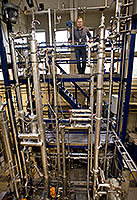Nov 12 2008
CO2 capture and storage is one of the leading points on the world agenda this year. Unless we can find a technology that can capture this problematic greenhouse gas and put it away safely, we are going to be in a bad way. The entire basis of our way of life depends on being able to balance our environmental accounts.
 Karl Anders Hoff, SINTEF, infront of the CO2-pilot He has ideas for chemicals that will reduce energy requirements by 50 percent
Karl Anders Hoff, SINTEF, infront of the CO2-pilot He has ideas for chemicals that will reduce energy requirements by 50 percent
SINTEF’s Karl Anders Hoff feels that he is privileged to be able to work in such a central aspect of the debate over the environment and society. CO2 capture has been his exclusive field of study ever since the nineties, when he was working on his MSc thesis at NTNU.
Now he is project manager for SOLVit, an eight year-long research and development programme financed by Gasnova and the Norwegian industrial company Aker Clean Carbon, which is also coordinating the programme. With a total budget of NOK 317 million, the project is one of the biggest in the world of its type.
Hoff and his colleagues at SINTEF are developing chemical scrubbing processes for capturing carbon dioxide, the greenhouse gas that is spewed out by factories and as flue gases from coal and gas-fired power stations. It is estimated that the 4000 largest such plants in the world are responsible for 40 percent of global anthropogenic CO2 emissions to the atmosphere.
The aim of SOLVit is to lower the costs of CO2 capture and storage.
- But you aren’t starting completely from scratch, are you?
"No, SOLVit is a result of a number of our previous CO2 projects. These have shown us which direction we ought to be going in, and that it is necessary to work in several fields and on many levels.
As a result, several of the scientists in my department are now working on CO2. At the moment, there are 17 of us in a special team, and since this project is due to continue for eight years, there will probably be more in the future".
- So it is still too expensive to capture CO2 today?
"Yes, the process requires too much energy. A power station that is generating electricity loses about 15 – 20 percent of its output by capturing CO2 . which is sufficient to make it unprofitable. A CO2 capture plant also needs a high level of investment. These costs mean that CO2 capture is not being implemented, and this is what we have to do something about".
- What is the solution?
"The key lies in the chemicals used. These have to be capable of binding CO2, but not so strongly that the gas cannot be released later on. Compounds called amines are used today, but we are looking for other chemicals that have more suitable characteristics".
- How does this happen?
"We are talking about cold flue gases from a gas-fired power station, that need to be “scrubbed” of CO2. The flue gases flow through a pipe or column, into which chemicals are sprayed at the top so that they can diffuse through the gas and bind to the CO2. The CO2-rich liquid gathers at the bottom of the pipe, after which it needs to be boiled in order to separate out 99.9% pure CO2, while the chemical mix is recycled in order to capture more CO2. Processes of this sort are widely used today to scrub industrial flue gases, but never on the scale that would be needed for a plant that deals with the CO2 from a coal- or gas-fired power plant".
- Have you identified good new chemicals?
"We are on the way there, and we have ideas for chemicals that will reduce energy requirements by 50 percent. The challenge lies in “having our cake and eating it”; i.e. finding chemicals that can react rapidly with CO2 while also needing little energy to release the CO2 from them afterwards. Perhaps what we need is a liquid that captures CO2 and then separates into two different phases, or one that turns the gas into a solid".
- A brand-new test plant should help you there?
"Yes, as part of the programme, we are building a large laboratory at Tiller in Trondheim at a cost of NOK 42 million. SINTEF is putting in 25 percent of the cost of the lab from its own funds. This will be a unique pilot-scale facility, with a 33 metre-high tower and a 25 metre-high scrubbing column, the sort of height that would be needed in an industrial scrubber. This will give us useful results. We can check whether the chemicals that we use are broken down in the long run, and whether they are hazardous waste".
- What does your timetable for the future look like?
"SOLVit will work on both short and long-term solutions, and the project is divided into three phases. Within the next few years, first-generation capture plants will be built in Norway, the UK and Germany. In Norway and the UK the state will support the construction of these plants, and potential suppliers are already tendering for the job in Norway. We already have a new chemical ready, which is due to be tested while we are developing other new contenders. We will also start work on longer-term solutions for second and third-generation plants".